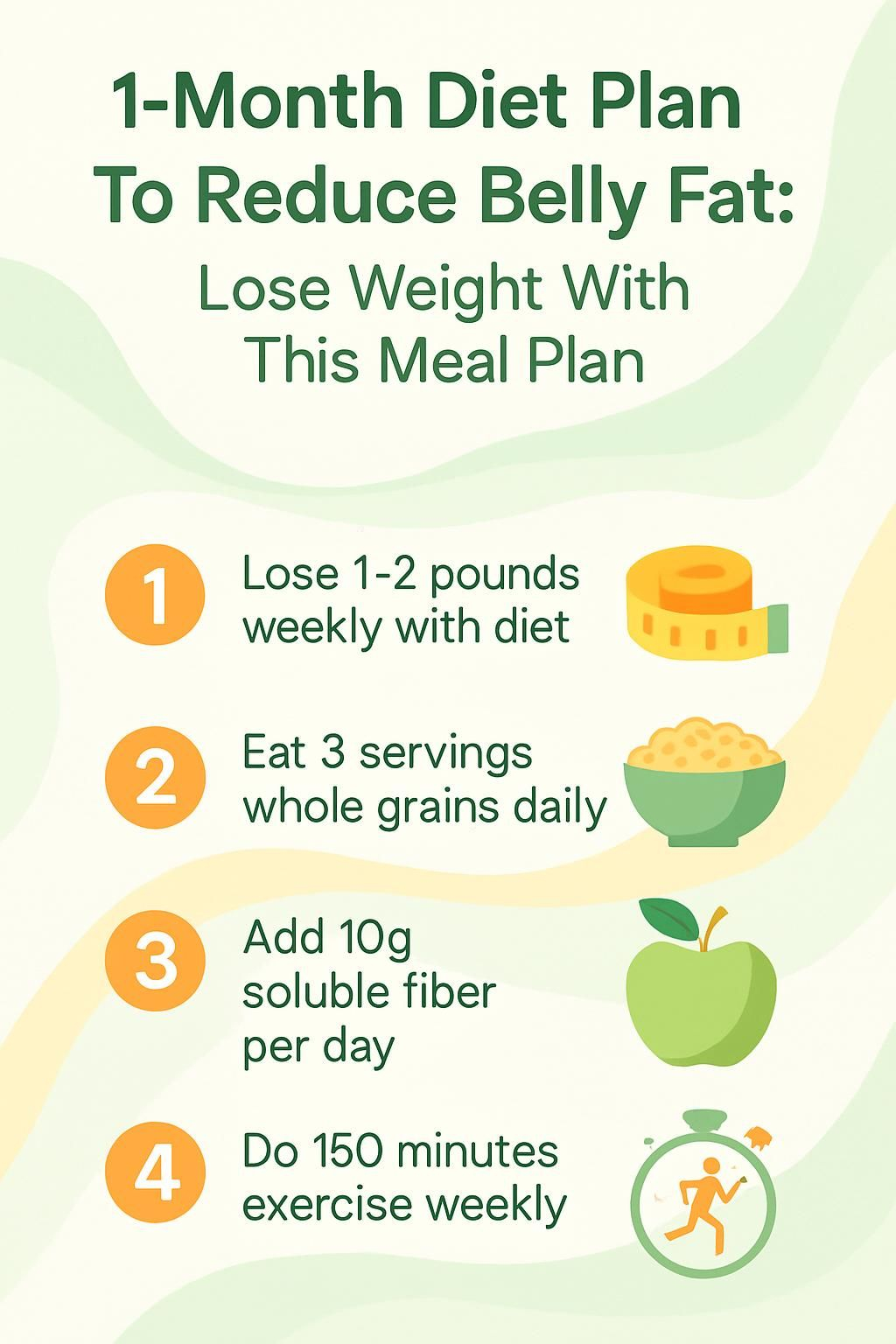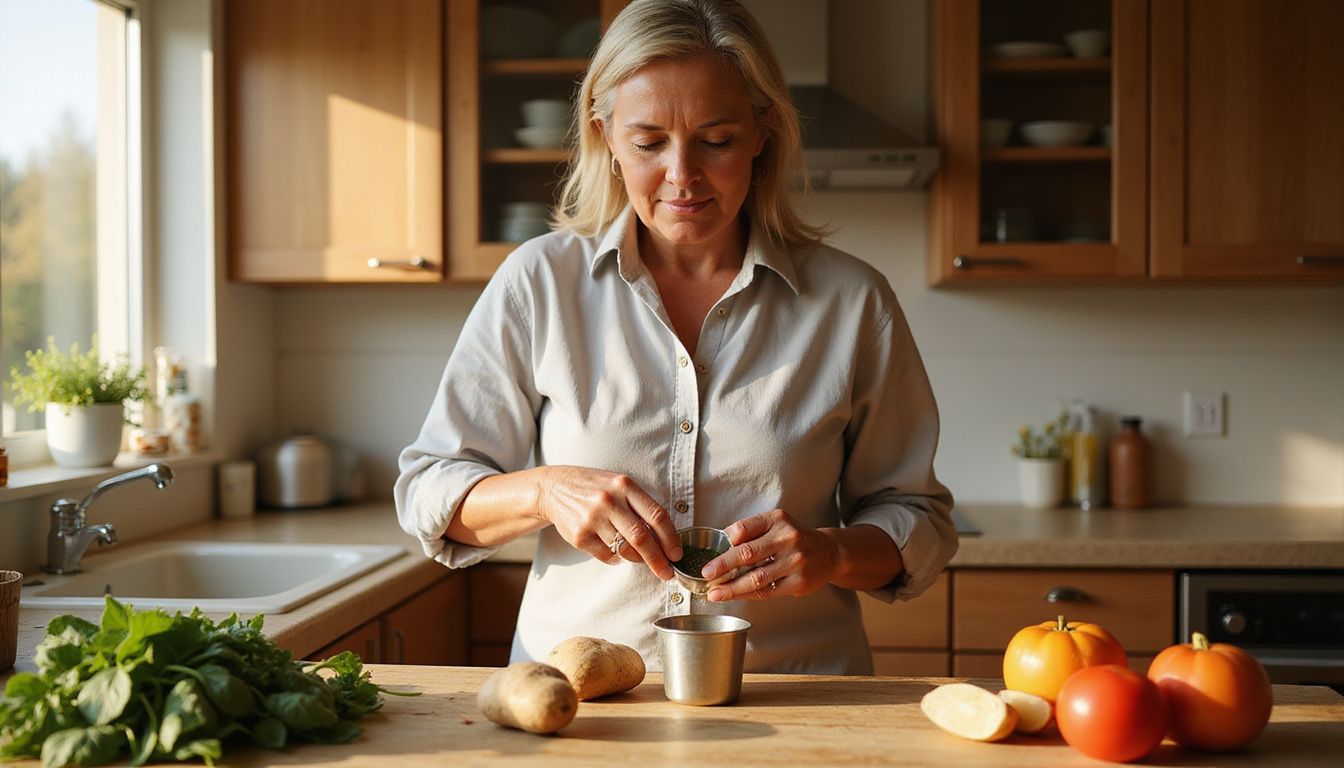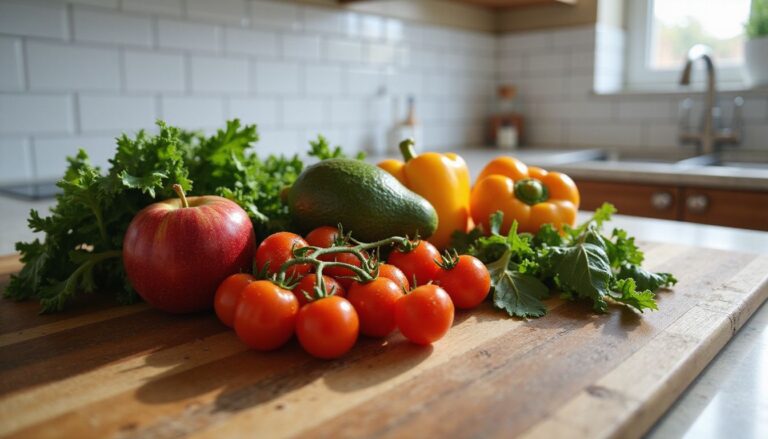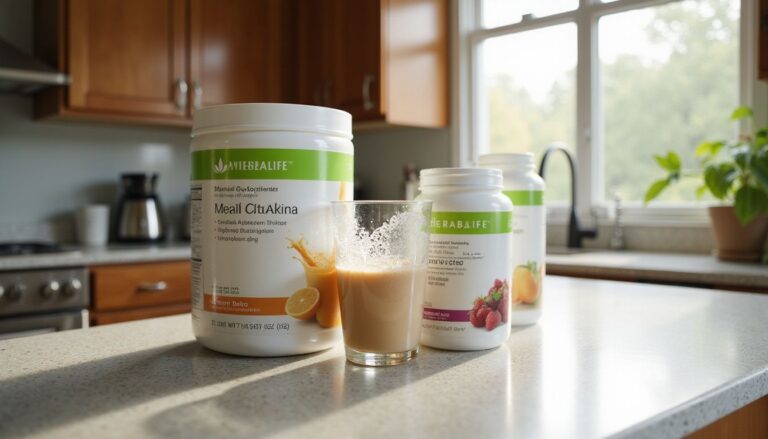1-Month Diet Plan To Reduce Belly Fat: Lose Weight With This Meal Plan
Our Nutrition Assistant AI Suite will transform your body. You will lose fat, get toned, and build muscle. Gain confidence and optimal health.
Many people struggle to lose belly fat even with diet and exercise. Reducing visceral fat, the deep fat around your organs, lowers your risk of heart disease and type 2 diabetes. This One Month Diet Plan To Reduce Belly Fat was created by registered dietitians to guide your weight loss with balanced meals, high fiber foods, and smart prep tips. Start now and see how a few daily changes can support steady results.
Key Takeaways
- A 1-month belly fat diet plan centers on high fiber foods, lean protein, whole grains, and calorie control. This approach supports a safe loss of 1 to 2 pounds per week (Harvard T.H. Chan, Obesity Science & Practice).
- Eating at least three servings of whole grains daily is linked with a 17% lower risk of excess abdominal fat (Framingham Heart Study, American Journal of Clinical Nutrition).
- Adding 10 grams per day of soluble fiber can cut belly fat gain by about 3.7% over five years in adults.
- Pair the meal plan with at least 150 minutes per week of moderate exercise for better visceral fat reduction and heart health.
- Simple portion guides, like palm-size protein and fist-size carbs, help prevent overeating and keep blood sugar steadier.

How This 1-Month Diet Plan Works
Think of this plan as a simple map for your plate.

This 1-month meal plan to reduce belly fat uses balanced nutrition and calorie control to support weight loss. A clear eating schedule helps you stay consistent without guesswork.
What balanced nutrition helps reduce belly fat?
Balanced meals keep you full, protect muscle, and support weight management. Build your plate with high fiber foods like artichokes, berries, beans, lentils, and whole grains. A 2024 Obesity Science & Practice paper links produce and whole grains with less visceral fat.
Add lean protein such as fish, eggs, or low fat yogurt to support muscle during weight loss. Include healthy fats from avocado, nuts, and seeds for satisfaction. Probiotic foods, like kefir or kimchi, support gut health and digestion. Limit ultra-processed snacks and high sugar foods since they slow progress.
I followed a dietitian’s plan last year. Swapping sugary drinks for water cut cravings within one week.
Balanced nutrition is not about restriction, it is about smarter daily choices.
How do calorie-controlled meals promote gradual fat loss?
Fat loss happens when you eat fewer calories than you burn. Cutting about 500 calories per day often leads to roughly one pound lost per week.
Use simple portions to help: three fist-size carb servings, two palm-size lean proteins, two cupped handfuls of vegetables, and two thumbtip-size servings of healthy fats. Structured portions support progress without feeling deprived. Recheck your calorie needs as your weight changes to avoid plateaus.
On my own plan, staying near 1,200 to 1,500 calories produced steady weekly losses. Whole foods tend to be higher in fiber and protein, which helps control hunger better than most packaged items.
Health note: speak with your healthcare provider if you have diabetes, take medications, are pregnant, or have any medical condition before changing your calorie intake.
Why is exercise important for belly fat reduction?
Exercise helps you burn calories and reduce total body fat, including abdominal fat. Getting 300 minutes per week of aerobic activity can create more fat loss than 150 minutes for many people.
Combine cardio with resistance training to protect muscle and improve body composition. Regular movement supports heart health and helps lower blood pressure. The Framingham research also links higher whole grain intake and an active lifestyle with less visceral and liver fat.
Aim for at least 150 minutes per week of moderate activity, like brisk walking or cycling. Tracking workouts in an app can boost motivation and consistency.
Foods to Include for Belly Fat Reduction
Target foods that fight hunger, steady blood sugar, and support a healthy diet. Knowing your best choices makes your eating plan easier to follow.
What are the best high-fiber foods for belly fat loss?
Top choices include raspberries, apples, pears, sweet potatoes, artichokes, lentils, beans, oats, and chickpeas. A daily increase of 10 grams of soluble fiber is linked with less belly fat gain over five years.
Start your morning with oats or quinoa to promote fullness. People who choose whole grains more often have a lower risk of gaining abdominal fat than those who rely on refined grains. Nuts and seeds add fiber and satisfying crunch to snacks.
Fiber supports digestion and feeds the good bacteria in your gut. This makes it easier to skip foods high in added sugar and empty calories. In my plan, trading dessert for an apple and adding roasted chickpeas as a snack reduced afternoon cravings.
High fiber foods keep you full longer, which makes weight loss more manageable during busy or stressful days.
Which lean proteins aid in reducing belly fat?
Choose skinless poultry, fish like salmon and shrimp, eggs, Greek yogurt, legumes, tofu, and low fat dairy. Aim for two palm-size servings daily.
These options are rich in protein and lower in saturated fat. Protein helps maintain muscle and supports your metabolism during a calorie deficit. High protein diets often improve fat loss and waist size compared to lower protein plans.
Protein-rich breakfasts, such as eggs or Greek yogurt with fruit, can curb early hunger. Limit processed meats to support heart health and reduce extra abdominal fat.
How do healthy fats contribute to fat loss?
Healthy fats help you feel satisfied and can reduce snacking. Include two thumbtip-size servings of fats or oils daily from avocado, nuts, seeds, or olive oil.
Omega-3 fats in salmon or walnuts support metabolic health. They may aid fat loss when eaten a few times each week. I found that nuts and seeds as snacks managed my hunger better during a lower carb phase. Using olive oil in salads boosted flavor without relying on processed oils.
Healthy fats also help your body absorb fat-soluble vitamins. Eating within your calorie targets and including these fats supports a sustainable loss of 1 to 2 pounds per week.
Why include whole grains in a belly fat diet?
Whole grains like oats, quinoa, muesli, and whole grain toast supply fiber, B vitamins, and minerals. In the Framingham analysis, people who ate more whole grains had lower odds of excess belly fat.
Choose whole grains at breakfast or as sides to support fullness. This also helps balance blood sugar and energy. Aim for three fist-size servings of carbs per day from options like oats, brown rice, or quinoa.
What low-sugar fruits and vegetables help reduce belly fat?
Low sugar fruits and vegetables add volume and nutrients without many calories. Good picks include berries, apples, pears, oranges, spinach, kale, asparagus, Brussels sprouts, artichokes, sweet potatoes, and eggplant.
Strawberries provide fiber with less sugar per cup. Apples and pears are rich in water and fiber, which supports gut health and appetite control. Leafy greens add antioxidants and very few calories, which helps you stay on track.
Include two fist-size servings of fruit daily and two cupped handfuls of salad or veggies. Limit fruit juice because a small glass can pack more sugar than several pieces of whole fruit. During a plant-focused week, I felt satisfied by loading plates with high volume, low calorie produce at each meal.
Week 1: Starting Your Belly Fat Reduction Journey
Small, repeatable steps set the tone for your month.
How to create balanced meals with portion control on Day 1?
Use your hand as a guide. Fist-size carbs, palm-size protein, and thumbtip-size fats. For breakfast, blend a Blueberry-Cranberry Smoothie, then add one medium orange for fiber and vitamin C.
At lunch, a Green Salad with Edamame & Beets gives plant protein and color. Have a large apple for an afternoon snack. For dinner, try Roasted Salmon with Smoky Chickpeas & Greens for protein, healthy fats, and complex carbs.
If you need more calories, add snacks like a small handful of almonds or walnut halves. Keep portions consistent to prevent overeating and to stabilize blood sugar.
How to increase water intake and choose fiber-rich snacks on Day 2?
Drink a glass of water before breakfast. Aim for at least 8 cups daily. Keep a bottle nearby and sip often.
Pick whole fruit instead of juice. A small glass of apple juice can contain about 24 grams of sugar and little fiber. Choose snacks like unsalted nuts, fruit slices, overnight oats, or a grain bowl to stay full longer.
Unsweetened tea is a good low calorie drink swap. These changes can support blood pressure and insulin control. On Day 3, you will shift to a protein-packed breakfast and a lighter dinner.
What makes a protein-packed breakfast and light dinner on Day 3?
Build breakfast with Greek yogurt, berries, and chopped nuts. One serving of Greek yogurt supplies about 15 grams of protein. Nuts add more protein and healthy fats for staying power.
Keep dinner lighter to support digestion and sleep. Choose grilled chicken or tofu with steamed vegetables like broccoli or carrots. Two palm-size servings of protein help you meet daily needs.
Many people find a larger breakfast and lighter dinner reduce late-night hunger. Plant-based bowls with beans or lentils are great if you prefer vegetarian meals.
References: American Journal of Clinical Nutrition (2021); Harvard T.H. Chan School of Public Health dietary guidance.
How to incorporate healthy fats into your meals on Day 4?
Healthy fats improve flavor and satiety. Use olive oil vinaigrettes on salads instead of creamy dressings. Add avocado slices to toast or salads for monounsaturated fat.
Snack on a small handful of walnuts for omega-3s. Sprinkle chia or flax seeds on yogurt for extra fiber. Research suggests nuts can raise Peptide YY, a hormone that helps you feel full after eating.
In my routine, adding avocado to lunch kept me satisfied longer than croutons. Choosing whole food fats like nuts and seeds helps you avoid highly processed oils.
What are the benefits of a low-carb day with leafy greens on Day 5?
Leafy greens are high in nutrients and low in calories. Spinach, kale, and romaine bring fiber, vitamins, and minerals without adding many carbs.
Prioritize salads and vegetable-forward dishes. Include a lean protein like grilled chicken or tofu and a small amount of healthy fat. Lower carb days can improve metabolic flexibility and may help break short plateaus.
How do detox drinks support hydration on Day 6?
Hydrating drinks help you meet your fluid needs with almost no calories. Try water with lemon, unsweetened herbal teas, or green tea.
Green tea contains EGCG, a compound studied for a small boost in fat burning when paired with regular activity. Replacing sweetened beverages reduces sugar and may limit bloating.
I noticed that a warm herbal tea in the afternoon cut my urge for snacks. Choose these drinks most days and save alcohol and sugary beverages for rare occasions.
Why rest and reflect on your progress on Day 7?
Rest resets your body and mind. Review your food log to spot what worked and what did not. Look for patterns in hunger and energy.
Adjust your plan for next week based on those notes. Rest days reduce burnout, especially if you trained hard. Set a non-food reward for hitting your first week goals to keep motivation high.
Week 2: Building Momentum
Consistency multiplies small wins.
How do fermented foods improve gut health on Day 8?
Fermented foods add helpful bacteria to your gut. Yogurt, kefir, kimchi, and kombucha supply probiotics that support digestion and nutrient absorption.
Regular intake is linked with healthier body weight and may reduce visceral fat over time. Enjoy Greek yogurt at breakfast or sip kombucha as a snack. When I added kefir daily, I felt less bloated and more comfortable.
What are healthy snack swaps with nuts and seeds on Day 9?
Trade chips or cookies for a small handful of almonds, walnuts, or mixed seeds. One third cup of unsalted almonds fits well in a 1,500 calorie plan and delivers protein and healthy fats.
Chia, flax, and pumpkin seeds add fiber to salads or yogurt. Keep portions small to manage calories. In my experience, these swaps reduced cravings and kept energy steady all afternoon.
Why include omega-3-rich meals on Day 10?
Omega-3 fats in salmon and walnuts support heart and metabolic health. Health experts suggest two to three servings of fatty fish per week.
These fats are linked with lower inflammation, which can support your weight loss journey. I track my intake by adding walnuts to oats and grilling salmon a couple of nights per week.
How to practice portion moderation effectively on Day 11?
Use your hand as a measuring tool. Protein equals your palm, carbs equal your fist, and vegetables equal a cupped hand. Serve meals on smaller plates and pause between bites.
Track what you eat to build awareness. Write down if you had a palm-size chicken breast or one cup of brown rice. These habits prevent mindless eating and support steady belly fat reduction.
What are balanced carb and protein combinations on Day 12?
Pair complex carbs with lean protein to steady blood sugar. Good pairs include brown rice with chicken, quinoa with tofu, or whole wheat pita with cottage cheese.
Balanced meals reduce spikes and dips in energy. They also help preserve muscle during weight loss. Limit alcohol since it adds calories and can disrupt metabolism.
How to experiment with plant-based meals on Day 13?
Try lentil soup, tofu stir-fry, or chickpea salad. Plant proteins and fiber help you feel full and may aid belly fat reduction.
Use a variety of vegetables and low sugar fruits to raise nutrient intake. A vegan chili with black beans kept me full longer than my usual meat stew.
Reference: https://www.ncbi.nlm.nih.gov/pmc/articles/PMC9467015/
How to enjoy a cheat meal in moderation on Day 14?
Plan a favorite food, track the calories, and keep it inside your weekly target. Use portion control and enjoy it slowly without screens.
If lunch is higher in calories, keep dinner lighter. I noticed cravings dropped when I allowed an occasional slice of pizza and then returned to my plan at the next meal.
References: Harvard T.H. Chan School of Public Health, The Nutrition Source; British Journal of Nutrition, 2020.
Week 3: Optimizing Your Diet Plan
Small upgrades compound into big changes.
How to prepare whole grain-based meals on Day 15?
At breakfast, choose whole grain toast topped with a boiled egg or avocado. Muesli with low fat yogurt and berries is another high fiber option.
For lunch, make a whole wheat sandwich with lean turkey or hummus and spinach. A quinoa salad with chickpeas and tomatoes also works well. For dinner, try brown rice with grilled chicken and steamed broccoli.
These ideas deliver at least three fist-size servings of whole grains daily. Studies link higher whole grain intake with a lower risk of belly fat.
Sources: Harvard T.H. Chan School of Public Health, Whole Grains; American Journal of Clinical Nutrition.
What is intermittent fasting and how to start on Day 16?
Intermittent fasting is an eating schedule that includes a daily fasting window. Start with a 12 to 14 hour overnight fast. For example, stop eating at 8 pm and have breakfast around 10 am.
Break your fast with protein, fiber-rich produce, and a little healthy fat. If you feel too hungry or low on energy, shorten the fasting window. Health note: check with your clinician before fasting if you have diabetes, take medicines, are pregnant, or have any medical condition.
Why add green tea to your daily routine on Day 17?
Green tea provides EGCG, an antioxidant studied for its role in fat metabolism. Replace sugary drinks with unsweetened green tea to cut calories and stay hydrated.
Drink 1 to 2 cups per day with meals or snacks. I like iced green tea at lunch to keep energy up without extra sugar.
How to limit processed foods for better results on Day 18?
Cook more at home using whole ingredients. Choose fresh produce, lean protein, and whole grains. Check ingredient lists and skip items with added sugars or trans fats.
Swap packaged snacks for nuts, fruit, or plain yogurt. Select brown rice or oats instead of white bread or pasta. NIH research links fewer ultra-processed foods with better weight management.
What are high-protein dinner options on Day 19?
Try grilled salmon with roasted broccoli, lemon chicken with sautéed spinach, or shrimp stir-fry with bell peppers and snap peas. Aim for 20 to 35 grams of protein at dinner.
Pair your protein with fiber-rich vegetables, then add a small amount of healthy fat like olive oil or avocado. Use a nutrition app to keep portions aligned with your goals.
How to choose low-calorie desserts on Day 20?
Pick simple, whole food desserts. Good options include Greek yogurt with berries, fruit salad without syrup, or chia pudding with unsweetened almond milk.
Keep portions under 150 calories when possible. I like a small bowl of frozen grapes, which feels like a treat with minimal calories. Fiber and protein in desserts help you stay full longer.
How to strengthen healthy habits and stay motivated on Day 21?
Make meal prep a routine. Prep a Green Goddess Salad or other easy dishes so choices feel simple during busy days.
Adjust calories as needed within a range that fits you, often 1,500 to 2,000 daily. Note wins like better energy or mood since you started. Use those gains to fuel the next week.
Week 4: Achieving Consistency
Turn what works into your default setting.
How to prepare effective meal plans for the week on Day 22?
Outline each day’s meals and snacks. For Day 22, breakfast is Jason Mraz’s Avocado Green Smoothie at about 307 calories, lunch is a Green Salad with Edamame & Beets at 325 calories, and the day totals roughly 1,184 calories with 57 grams of protein and 35 grams of fiber.
Batch cook Chipotle-Lime Cauliflower Taco Bowls for Days 23 to 26. Store in containers for fast assembly. Adjust portions for your calorie needs. Pre-planning kept my choices easy and helped me meet daily nutrition targets.
Why reduce sodium intake on Day 23?
On Day 23, aim for about 1,404 milligrams of sodium to help reduce water retention and belly bloating. Processed foods are the main source of excess salt, and they often add extra calories and unhealthy fats.
Lower sodium intake is tied to reduced blood pressure. Cooking at home with fresh ingredients gives you better control of salt and quality.
| Focus | Fact or Strategy |
|---|---|
| Sodium Limit | About 1,404 mg on Day 23 |
| Main Benefit | Less water retention and reduced bloating |
| Health Factor | Supports lower risk of hypertension |
| Meal Prep Tip | Use fresh foods and cook from scratch |
How to swap sugary drinks for water on Day 24?
Replace soda, sweet tea, and sugary mixers with water at meals. This can cut hundreds of calories in a day. Limit juice or dilute it with water.
Add lemon, mint, or sliced berries to water for flavor without calories. Carry a reusable bottle to make the choice easier. Track your drinks to see progress. Next up, you will use spices to nudge your metabolism.
How do spices help boost metabolism on Day 25?
Spices like cayenne, black pepper, ginger, and cinnamon can gently support metabolism. Capsaicin in chili peppers may raise calorie burn after meals. Piperine in black pepper supports fat breakdown.
Ginger and cinnamon help with digestion and appetite control. I used more turmeric and ginger in meal prep, which boosted flavor while letting me use less salt.
| Spice | Key Compound | Effect | Common Uses |
|---|---|---|---|
| Cayenne Pepper | Capsaicin | May increase thermogenesis | Eggs, soups, roasted vegetables |
| Black Pepper | Piperine | May limit new fat cell growth | Stir-fries, meats |
| Ginger | Gingerol | Supports digestion | Teas, smoothies |
| Cinnamon | Cinnamaldehyde | Helps regulate blood sugar | Oatmeal, yogurt |
Including a variety of spices supports flavor and metabolic health while staying within your calorie goals.
How to listen to hunger cues for better eating on Day 26?
Notice signs like stomach growls, low energy, or trouble focusing. Pause before eating and ask if you feel physical hunger or if a trigger like stress is present.
Eat slowly. Set your fork down between bites and sip water before meals. Over time, honoring true hunger helps you avoid extra calories.
What is mindful eating and how to practice it on Day 27?
Mindful eating means paying attention to taste, texture, and fullness. On Day 27, try Creamy Blueberry-Pecan Oatmeal for breakfast, No-Noodle Eggplant Lasagna for lunch, and Romaine Salad with Grapefruit & Shrimp for dinner. The day totals about 1,215 calories, which you can adjust as needed.
Turn off screens while eating. Take small bites and chew well. Pause to gauge fullness before finishing your plate. Mindful habits can reduce emotional eating and improve digestion. This approach helped me break a plateau last summer.
How to reflect on long-term weight loss goals on Day 28?
Look back at your log and note what worked for belly fat reduction. Check how often you followed your calorie plan and portion guide.
Ask if these routines fit your life long term. Did high fiber meals get easier? Did water replace sugary drinks most days? Set the next goals around consistency and maintenance.
Conclusion
A focused 1-month meal plan can help you lose belly fat and improve health. You center your days on fiber-rich foods, lean protein, whole grains, and smart calorie targets. Pair this with regular exercise for better results.
Follow guidance from registered dietitians and track your progress weekly. You will likely see a smaller waist, more energy, and better habits that last. If you have a medical condition, talk with your healthcare provider before making major changes.
Start today with one small change. Your next meal or walk can move you closer to your weight loss goals and lower visceral fat over time.
FAQs
1. What foods should I include in a 1-month diet plan to reduce belly fat?
A balanced meal plan for reducing abdominal fat includes lean poultry, whole grains, leafy greens, beans, and low-fat dairy. Studies show that diets high in fiber and protein can help decrease waist size while supporting weight loss (Harvard T.H. Chan School of Public Health). Limiting added sugars and processed snacks also supports this goal.
2. How many calories should I eat daily to lose weight with this meal plan?
Most adults need between 1,200 and 1,800 calories per day for healthy weight loss depending on age, sex, activity level, and starting weight (Centers for Disease Control and Prevention). Tracking your intake helps ensure you stay within the recommended range.
3. Can exercise improve results from a one-month belly fat diet?
Physical activity such as brisk walking or cycling increases calorie burn which can speed up abdominal fat reduction when combined with a structured eating pattern (American College of Sports Medicine). Aiming for at least 150 minutes of moderate exercise each week is effective according to research.
4. Is it possible to see visible changes in my waistline after following this meal plan for one month?
Many people notice some reduction in their midsection after four weeks if they follow the dietary guidelines closely along with regular movement. In my experience tracking meals using a food journal helped me stay consistent; over several weeks my clothes fit better even before seeing big changes on the scale.
Summary: Eating nutrient-rich foods like vegetables and lean meats while limiting sugar helps target stubborn abdominal areas. Combining these habits with regular physical activity improves outcomes based on scientific evidence.







